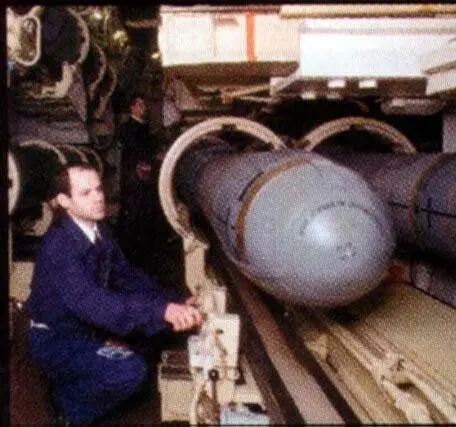ESTABLISHING DATUM CONDITION OF THE REACTOR PLANT AND SAFEGUARDS
The NCG’s strategy required a detailed assessment of the potential damage to the containment, fuel and nuclear shutdown/hold down components of the two nuclear reactor systems.
The determinant of a safe and complete shutdown was, primarily, the ability of each reactor’s fuel and shut down systems to function adequately during or immediately following the high levels of impulse loading from the torpedo explosions. Each reactor is supported in a resilient cradle providing shock absorption to cater for an impulse well in excess of 50g, defined by military operations of the boat. To determine the actual loading in the immediate aftermath of the explosions, forensic examination was undertaken on two of the casualties recovered from the stern section, these being identified as the reactor control room operators. These casualties had sustained skeletal damage indicative of body shock loading of just over 50g. This provided a degree of reassurance that the reactor resilient mounts, being below or about the design limit, had not been damaged and that the reactors could have closed down automatically as intended after power supplies had been lost.
Other factors relating to the condition of the reactor systems included:
i) The shock level (~50g) would have also temporarily disoriented the reactor control personnel who would not have been expected to recover for several minutes by which time most, if not all, of the power required for operator intervention would have been lost;
ii) the shock would have caused opening of electrical circuit breakers leading to loss of power, e.g. to the main coolant pumps;
iii) automatic reactor shutdown sequences would have been initiated probably by the above power loss — this sequence causes the insertion under gravity, with spring and pneumatic assistance, of two diverse means of neutron absorption which then lock into place, and the initiation of decay heat removal which makes use of the large thermal capacity of the water in the shield tank — this sequence cannot easily be interrupted by the operator and it was unlikely that its essentially passive role was impeded by the shock loading;
iv) the reactor shutdown and decay heat removal equipment had a design basis for an inclination of the submarine in excess of 45° for forced cooling during pump spin down, and thereafter a lesser angle of inclination for heat dissipation by natural circulation — the depth of water (108m) in conjunction with the submarine’s length (155m) precluded a larger inclination — in view of the perceived accident sequence it is probable that the maximum trim angle was much less than 45º, although this may have been exceeded for a few seconds or more when the hull responded to the expansion of the explosive gas products; and
v) the design provides four barriers to the escape of fission products (or particulates) from the nuclear fuel. These comprise the fuel assembly cladding, the reactor primary circuits, and the reactor shield boundaries.
To confirm the state of the reactor the RF deployed gamma spectroscopy in the range 4 to 8 MeV (characteristic of reactor operation) in the lower regions outside the pressure hull and the thermal gradient in the flood hull space was profiled to detect any thermal input. Negative results suggested that:
i) the reactors remained shutdown;
ii) there was effectively no contamination (e.g. fuel particulate) in the shield tank, suggesting that the reactor primary circuit containment is complete;
iii) there is no contamination between the shield tank and the pressure hull, suggesting that the shield tank containment is complete; and
iv) the lack of any thermal gradient indicated that no significant heat was being generated in either of the reactor compartments.
On this basis, the NCG’s criterion that at least two of the reactor containments be in place was satisfied.
ESTABLISHING DATUM CONDITIONS FOR THE MUNITIONS
Torpedoes:At the time of sailing the Kursk was carrying 24 torpedoes, two with dummy warheads, the remainder with conventional explosives, and all stored within № 1 compartment. Analysis of the acoustic data from the cruiser Pyotr Veliky suggested that around seven torpedo rounds were destroyed as a series of explosions in rapid succession. The survey of the second debris field revealed a number of torpedo components but these, collectively, did not account for the remaining 15 or so armed rounds.

Port torpedo loading on Kursk
These missing rounds could have been hidden within the hull, particularly in the mangled wreckage of what remained of the bow compartment and some could have been thrown into the wreckage of the second compartment (which was subsequently shown to be the case when the internals of the wreck was dried out and inspected at Rosljakovo). Some or all of the rounds could have burnt during the explosions, some might have fragmented, and others might remain intact and hidden under the submarine hull.
Such was the uncertainty surrounding the presence, state and stability of these missing torpedo rounds that an explosion from this source had to be considered a credible fault condition at any time during the lift operations. Factors in mitigation were:
i) the dispersion of the remaining torpedoes and fragments of torpedoes, made a sympathetic detonation less likely;
ii) detonation would be unconfined and not directed through the hull towards the reactor compartment (compared to the original explosion that was initially confined by the pressure hull);
iii) the design basis capability of the reactor plant to withstand shock remained available (to an undeclared amount); and
iv) any fragment revealed during silt clearance etc., be removed by the RF, using remotely operated equipment to at least 70m from the submarine — torpedoes and fragments within the cut zone would also be removed.
v) the silt clearing equipment was unlikely to cause detonation of a torpedo or explosive fragment.
The NCG nominated a fault condition whereby the equivalent of two torpedo rounds (~450kg TNT in total) simultaneously detonated during the bow separation operation or the lifting operation. The NCG sought assurance, with explanations, from the RF of each reactor’s capability to withstand such an explosion. In addition, an analysis of the effect of the explosion gave the strength requirements of the hull plating of the attending barges and the length limitation for smaller vessels attending the barges, a requirement that these be larger that the sea surface bulk cavitation and gas bubble diameters that would put smaller vessels at risk of sinking. Also, the analysis provided the minimum lashing requirements for the heavy equipment operating on the barge decks, particularly the two 60t crawler cranes working on the Giant 4 lifting barge, in account that these could topple into the sea and descend onto the Kursk in the reactor compartment area or onto the cruise missile silos.
Missiles:At the time of loss, the Kursk was armed with 23 SS-N-19 GRANIT cruise missiles with conventional explosives. These missiles were located in forward slanting silo tubes, 12 either side of the submarine, the first being just behind № 1 compartment and within 3m of the cut line that was to isolate the bow wreckage, and the last two missiles being some 30m ahead of the reactor compartment.
Relevant features of the SS-N-19 missiles are:
i) the propellant fuel is kerosene, with a small (7kg TNT equivalent) powder charge for ejection from the silo to the turbojet firing altitude above the sea surface;
Читать дальше













